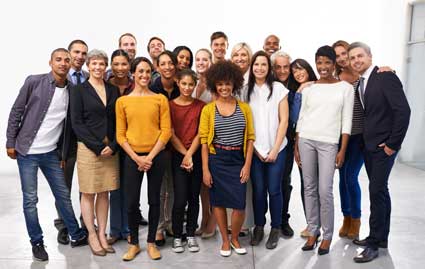There are dozens of web design programs available on the Internet today. These programs vary in difficulty, from WYSIWYG (What You See Is What You Get) editors for those people with little to no experience to more complicated programs for professional web designers. What program you choose to use when you want to design a website will depend on your experience level and your knowledge of code such as HTML and CSS.
For years now, Adobe has arguably produced the best graphic and web design software programs. Whereas Microsoft has the market cornered on software programs pertaining to data, Adobe certainly is the master of all things graphic. The popularity of their programs has even contributed to new words in the English language. How many times have you heard, "I bet that picture was photoshopped?" Of course, Photoshop is a photo editing program made by Adobe.
That said, Muse CC is a newer program created by Adobe. Muse CC is a web design program, as is Adobe Dreamweaver. However, while Adobe Dreamweaver is for the person who is more experienced with web design and writing code, Muse CC is for the amateur. You don't need to know how to write code to use Muse CC. In fact, you won't see a bit of code the entire time you use the program.
Instead, Muse CC is a WYSIWYG editor. Most of the web designing you'll do in Muse CC is nothing more than drag and drop. In other words, it's easy as most WSIWYG editors are. However, since Muse CC is from Adobe, you can expect the amazing bells and whistles that make it great. Just as Photoshop is ten steps ahead of other photo editing programs, you'll find that Muse CC is one of the best (if not the best) WSIWYG editor on the market today.
What You Can Do with Muse CC
Muse CC is a web design program, which means that you can use Muse CC to create websites by allowing you to easily design pages for a website. Muse can be used to create personal or business websites, ecommerce sites or educational sites, as well as small or large sites. Whatever type of site you want to create, you can use Muse CC to create it.
However, there are a few things to keep in mind when using Muse CC so you are not disappointed. Since it is a WSIWYG editor, it is intended for those who want a simple program or don't know how to write code. If you want to create a fancy website and add a lot of your own code to your pages, then Adobe Dreamweaver will probably be the better program for you. Muse CC is simple. It makes designing websites easy � and even fun. Plus, the websites you create using Muse CC can look just as attractive and professional as any website you could design using Dreamweaver or any other web design program. Muse CC just makes it (again) easier.
Downloading Muse CC
Muse CC (or Muse Creative Cloud) is part of the Adobe Creative Cloud family of software. The Creative Cloud software is available by subscription, which means you pay a monthly price to use the software. As long as you pay the monthly price, you have access to the program. If you stop paying, your access is revoked, but you can start paying again at any time for just the regular monthly price.
Because you download Muse CC to your computer, you need an Internet connection to download the program. However, you do not need an Internet connection to use Muse CC. Once the program is installed on your computer, you can use Muse CC at any time as long as your subscription fees are paid. Muse CC works in the same as any other software program that you purchase and install on your computer. The only difference is you pay for it monthly as a subscriber.
To download Muse CC, go to the Adobe website where you'll find a free trial for the program. Even if you plan on subscribing to Muse CC, it's advised that you take advantage of the free 30 day trial. You do not need a credit card to access the free trial. All you need to do is sign up for an Adobe account using your email address, then download Muse CC.
The Muse CC Welcome Screen
Once you have Muse CC installed on your computer, you can open it even if you are not connected to the Internet. The Muse CC icon looks like this:
When you open Muse, you'll see the Welcome Screen, as pictured below.
The Welcome Screen gives you several options.
Create New. You can create a new site by clicking Site under the Create New Section.
Open a Recent Site. You can open up a site you've already started working on in Muse under the Open a Recent Site section. Muse lists your recent sites, as shown above, or you can click Open to search for a site on your computer.
Planning Your Website
There is one thing that all successful websites have in common. They were planned. Look around on the Internet. Take note of some of the most beautiful websites, the most user-friendly websites, and the biggest websites. Those websites were not designed by someone who sat down to a program like Muse CC and simply starting throwing things on pages. Not at all.
Hours, days, and sometimes weeks of planning went into that website before they ever started to design the first page. The design team looked at websites similar to the one they wanted to create. They took notes. They came up with a theme for the website, then jotted down the content that needed to be covered under that theme. They did the majority of the work before they ever started to design the site. In fact, designing the site almost seems like the downhill slope because so much planning goes into creating a successful website.
This article is devoted to planning your website. If you are following along in Muse CC as you take this article and plan on completing assignments as well as exercises, it's advised that you put extra time into this article. It will make it easier to complete assignments, plus it will result in a more attractive, professional website.
About Web Design
If you are already designing your own websites, chances are you may know some of this. However, everything we are about to say will factor into your website at some point in time, so it's important that we cover it.
Web design is about more than putting images and text on web pages, linking those pages together, then publishing them to the Internet. If that were all that went into web design, it wouldn't take long at all to put together a website. The truth is that web design includes graphic design, content writing, search engine optimization (SEO), as well as marketing. These are all aspects that you need to incorporate into your website if it is going to be successful.
Let's put it this way. Your website is more than just a brochure. It's more than just your "home base" on the Internet. Your website is the visual representation of you, your business, your products, or your services. Your website is your store, even if it's not a commercial website. People must be able to find your store. When they do, your store must look good. It must be arranged properly so people can find what they need. Your store must provide people with the information they need as well.
The Purpose of SEO
Search engine optimization (or SEO) is too big of a topic to cover in a course about web design. However, you should know the basics of SEO before you ever start to design a website. In short, SEO is what will help bring people to your website. Sure, when you get your website designed, you are going to tell family, friends, colleagues, and associates about it. You may even run ads online to tell strangers about your website and bring them to you.
However, you only know a limited number of people, and advertising gets expensive. That said, you are also going to want the search engines, such as Google, to bring people to you. Yes, you are going to want your website to show up in search results. That is free traffic, and it ensures you always have people coming to your website.
SEO is the process of optimizing your site for the search engines. In other words, you want to make your website so attractive to the search engines that the search engines want to recommend your website above thousands of others. As we said at the beginning of this section, SEO is a huge topic, much too huge of a topic to cover in this article. However, we have put together some tips to help you optimize your site for the search engine as you start to plan, then design your site. Whenever we give you an SEO tip, you will see a yellow box with "SEO TIP" written in black. When you see that box, you'll know that whatever you are learning is also important to SEO as you design your site, so you might want to pay it a little special attention.
Brainstorming Ideas for Your Website
Planning your website starts off with brainstorming ideas for your website. Brainstorming will take on four major parts: theme, content topics, layout, and design. It's important to brainstorm each of these parts separately, and it's also important to do them in order. Don't try to brainstorm design ideas first because your design ideas might not match your theme. Don't try to brainstorm layout ideas before content topics, because the layout might not accommodate the topic.
That said, you are going to need two things to successfully brainstorm ideas. Pen and paper (or a blank word processing document) and an Internet connection. With your web browser and your pen, you are going to produce all the ideas you need to start planning your website.
Producing a Theme
Ask yourself this question. What is your website going to be about? If you own a shoe store, your website theme might be shoes. If you are a basket weaver, your website theme might be baskets. If you make bracelets, bracelets would be your theme. In fact, you may already know your theme. However, it's important to narrow your theme down to as few of words as possible, such as "bread and butter."
Listing Content Topics
Once you have your theme, you want to list content topics that relate to your theme. It is very important � very important � that the content topics you choose for your website relate to your theme. Content topics are simply things you are going to talk about on your website. You may write articles about these topics, show videos, share pictures, sell products, etc.
Keep these first content topics very general. Don't worry about producing a lot of topics at this time. Here's an example of content topics for someone creating a site about and selling bracelets:
At this point, all you need is a general list of content topics as listed above.
These content topics are also keywords. Search engines index your site for keywords. Try to pick just one or two keywords per page. The easiest way to do this is by picking a topic for each page. The topic becomes your keyword. If we use the example above, you would create a page about metal bracelets. All the content on that page would focus on metal bracelets. It goes without saying that you would use the phrase "metal bracelets" in the text you created. Your keyword would occur naturally and help optimize your site for the search engines.
Once you have your general topics, you can break those topics down into sub-topics. You might include "how to make metal bracelets," "supplies needed to make metal bracelets," "different types of metal bracelets," "popular metal bracelets." List the sub-topics under each topic. You can even create a tree that looks something like this:
Note that at the top of the tree you have your theme.
Below the theme are your content topics.
Below the content topics are your sub-topics.
You can keep expanding your tree if you want by adding sub-topics to your sub-topics.
As you continue to brainstorm topics, you are listing some of the pages you will need, and you are also brainstorming keywords.Layout Ideas
Now that you have two parts of the brainstorming done, it's time to move on to layout. Take time to visit sites that are similar in nature to the one you are going to design. Look at sites with a similar theme, but you can also look at sites who have a similar purpose. For example, if you are designing a site about bracelets, you can also look at sites about other types of jewelry to get ideas.
Take note how these sites are laid out. How are their pages organized? How do they group the pages together? In the example above, we grouped pages together by topic, and we chose topics by the types of bracelets.
Look at how they place pictures, text, and video on the websites too. Look at the colors they use, and the types of images and graphics. Jot down notes regarding the things you like. You can also take screenshots of pages that you like and refer to them as you start to design your own site.
Design
Of course, design includes the layout, but in this part of the brainstorming, pay special attention to color schemes and the overall look and feel of your website. Again, look at other websites and write down ideas you like and take snapshots. It's important to get a feel for what you want.
Here you can decide if you want to use a lot of video or a lot of text � or a balance. You can start to decide what elements you want to incorporate into your design. Do you want a "latest news" section like a lot of websites have nowadays? List things you like about other websites, even the smallest features.
Storyboarding Your Website
Once you are done brainstorming, it's time to start storyboarding your website. If you've done enough brainstorming, this will be fairly easy.
Storyboarding involves drawing out a diagram of your website either by hand or using a graphics program, then drawing out a diagram of the layout of the pages. You can even add colors if you are using a graphics program or make notes of colors if you are doing it by hand.
Here's an example of a storyboarded website diagram. Note that it lays out the pages that will be in our website. When we incorporate our plans with Muse CC, we'll have the start of our navigation system.
Note that we haven't completed the diagram for our entire example website. This is just an example to you started.
Note that each box above represents a page. Note how we've used keywords and key phrases to in each box. These will also become the names of our pages so that they are also keywords. For example: make_metal_bracelets.Storyboarding Your Pages
Once you have your pages listed, you can start to storyboard the layout for the different pages. Don't worry if you are not sure about the layout for each page. Some of this can be figured out later as you design your pages. In fact, you are sure to make changes as you start to design your site. Planning will just save a lot of time and result in a more organized website.
Here's an example of a storyboarded web page:
Use your research from when you were brainstorming to diagram page layouts. Again, these don't h






























